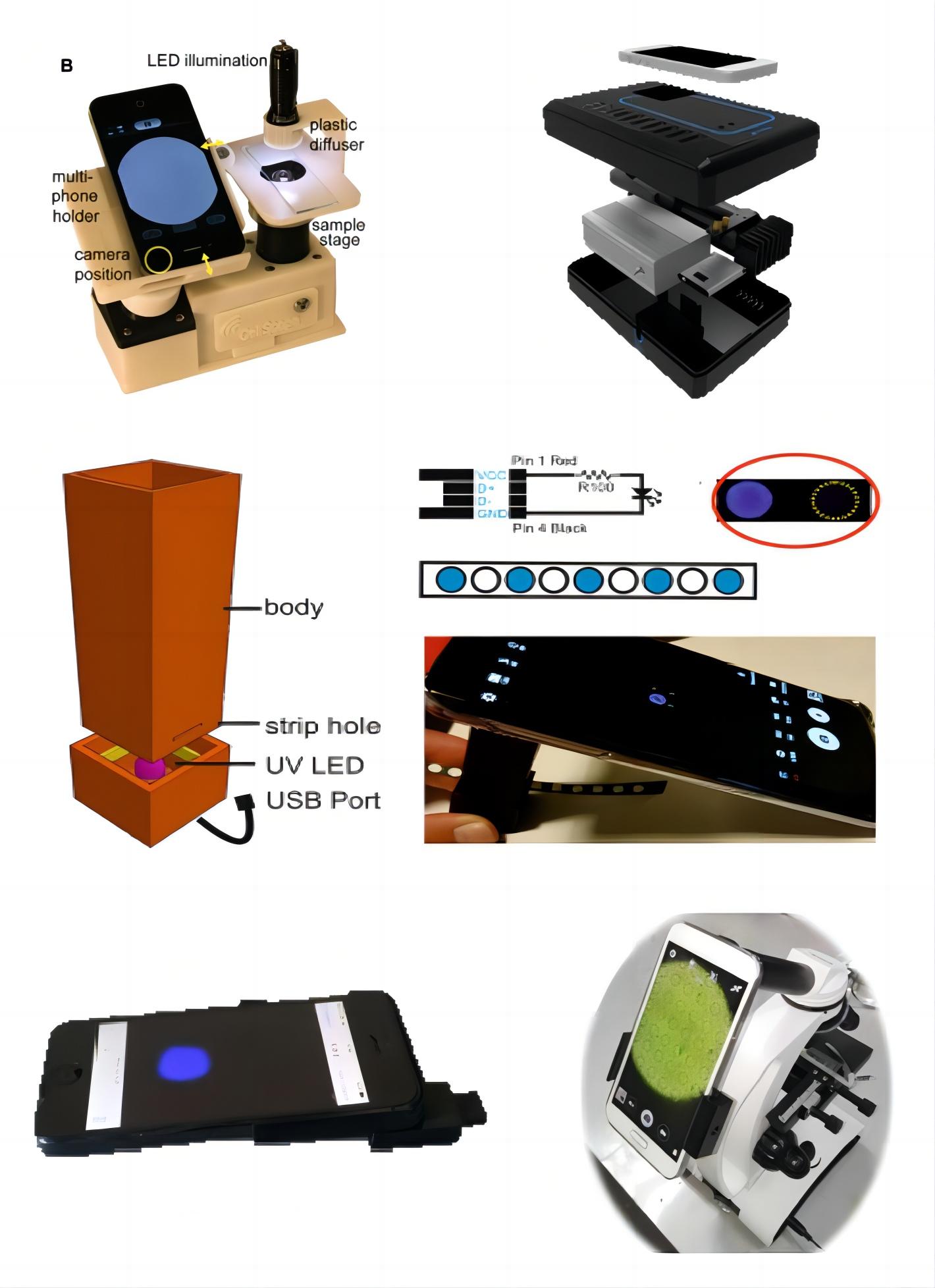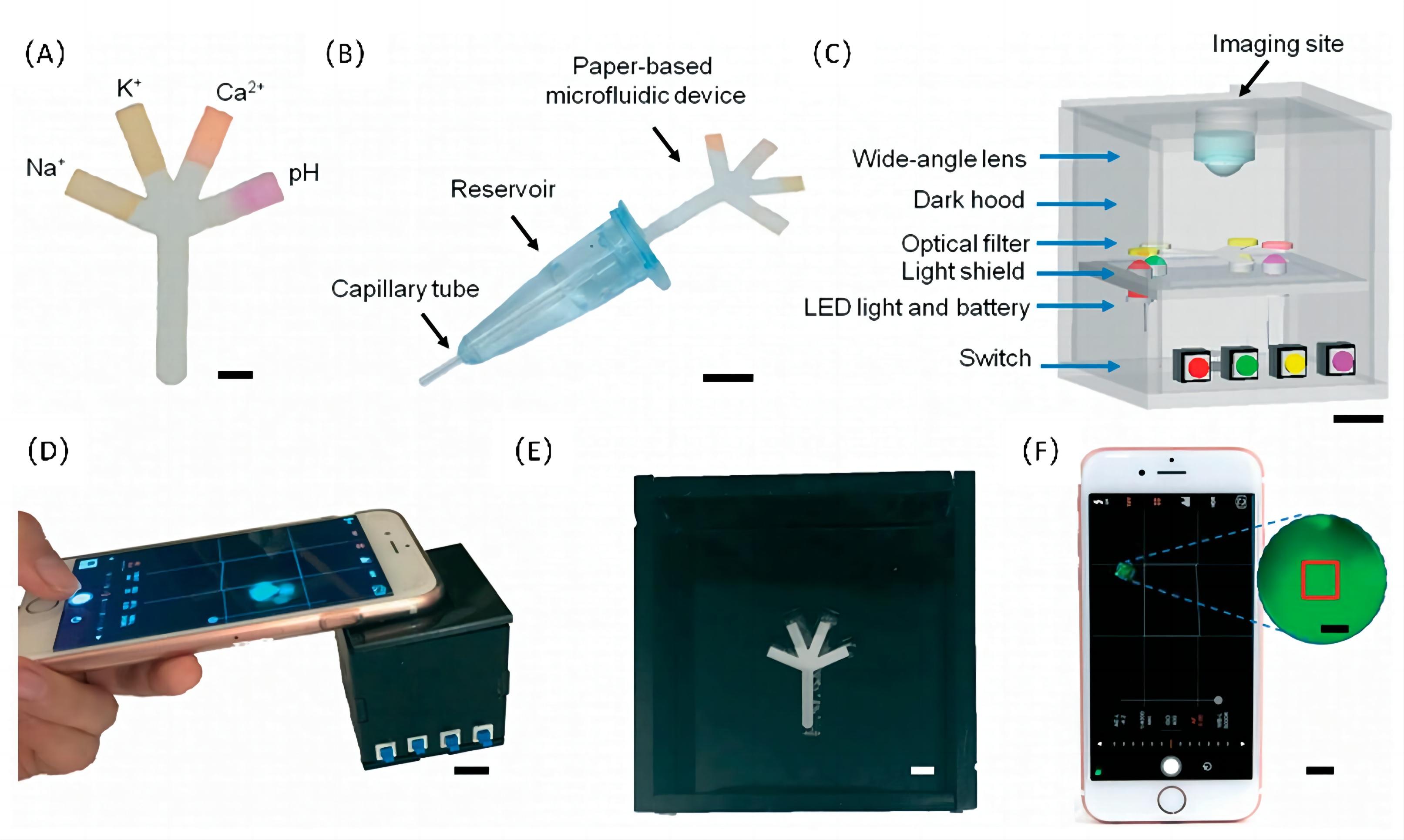Smartphone-based point-of-care (POC) technologies have emerged as ideal next-generation point-of-care devices (POCD) for in vitro diagnostics (IVD). The smartphone’s high-resolution rear camera, ranging from a few megapixels (MP) to 41 MP, can be transformed into a potential POC reader to detect colorimetric, fluorescence, luminescence, spectroscopy, and other optical signals. Numerous low-cost and compact SP-based readers could be deployed at POC settings for several bioanalytical applications. Until now, a wide range of SP-based POC fluorescence readers has been developed for various analytes and multifarious bioanalytical applications. Fluorescence microscopy uses fluorophore-conjugated antibodies or other fluorescent stains to identify certain cell markers. These fluorophores are excited when an electron absorbs energy from a specific wavelength of light, when the electron returns to its ground state, light is released and detected by a camera.
 Fig.1 Biochemical applications of smartphone adapter.1
Fig.1 Biochemical applications of smartphone adapter.1
Application of Fluorescence Detection
- POC detection of somatotropin antibodies in food
The detection is based on somatotropin bound covalently to paramagnetic microspheres that bind to anti-somatotropin antibodies in food, followed by the detection of the immune complex by binding to QD-labeled detection antibodies. The fluorescence of the bound QD-labeled detection Ab detected by the developed smartphone attachment has the same bioanalytical performance as the newly developed planar imaging array but with additional features for POC detection: external power supply, wireless connectivity, increased portability, and improved cost-effectiveness.
 Fig.2 Smartphone-enabled measurement of tears electrolytes via paper-based integrated microfluidic system.2
Fig.2 Smartphone-enabled measurement of tears electrolytes via paper-based integrated microfluidic system.2
- POC detection of virus
The smartphone-based POC device uses a loop-mediated isothermal amplification (LAMP) assay and a Microfluidic diagnostic chip for the detection of virus. The excitation of the fluorescent dye is feasible using the smartphone’s flashlight via an excitation filter, while the fluorescent emission is measured by the SP’s back camera via an emission filter. The SP images are transferred to a computer, and the average fluorescent intensity of the images is determined by a custom-developed MATLAB-based image analysis software.
- POC detection for urine and blood
Smartphone devices for the testing of albumin in urine use a fluorescent assay in disposable test tubes and an smartphone attachment. The compact and lightweight smartphone attachment is mechanically installed on the existing back camera unit of the smartphone. The weakly scattered excitation light is rejected by an interference filter. The smartphone camera captures the images of the fluorescent tubes perpendicular to the direction of excitation using a plano-convex lens inserted between the interference filter and the smartphone back camera. The developed albumin assay employs a simple sample preparation and incubation, which takes about 5 min per test and detects albumin in the urine.
Advantages of Fluorescence Detection
POC diagnostics offers several advantages: portable, inexpensive, rapid, and easy-to-use. These features have provided POC diagnostics with an indispensable role in global and public health. In the control and treatment of infectious and chronic diseases, it can provide timely diagnostics for tuberculosis (TB) and human immunodeficiency virus (HIV), effectively preventing the spread of these diseases, and provide continuous, long-term monitoring services for diabetes mellitus and cardiovascular diseases. Besides, POC diagnostics have shown great potential in environmental monitoring and food safety analysis.
References
- Alawsi, Taif, and Zainab Al‐Bawi. "A review of smartphone point‐of‐care adapter design." Engineering Reports 1.2 (2019): e12039.
- Yang, Shih-Mo, et al. "Microfluidic point-of-care (POC) devices in early diagnosis: A review of opportunities and challenges." Sensors 22.4 (2022): 1620. Distributed under Open Access license CC BY 4.0, without modification.
For Research Use Only.

